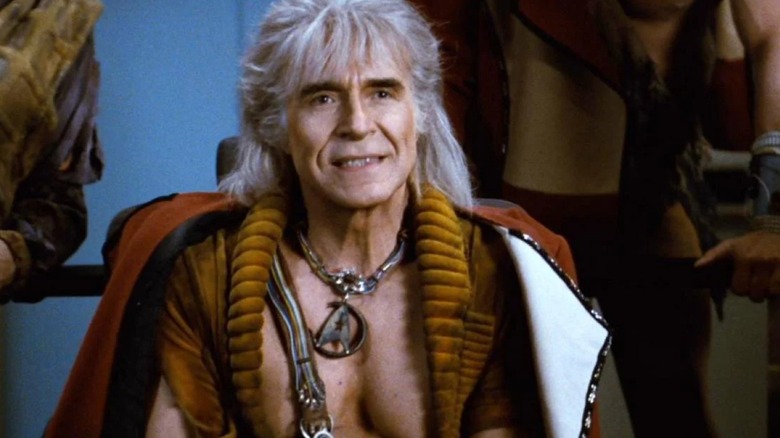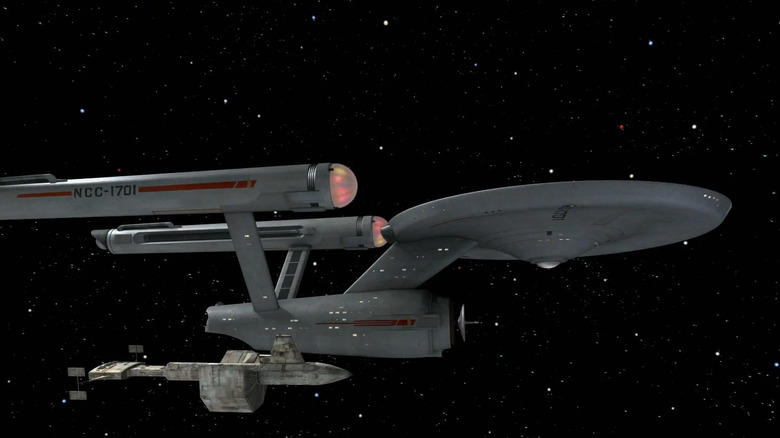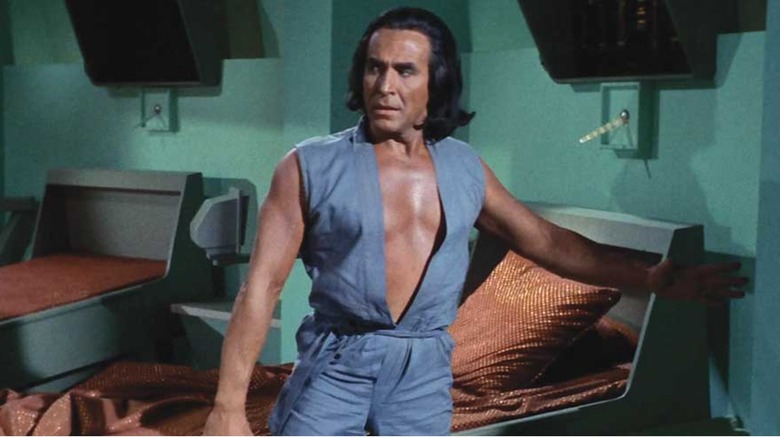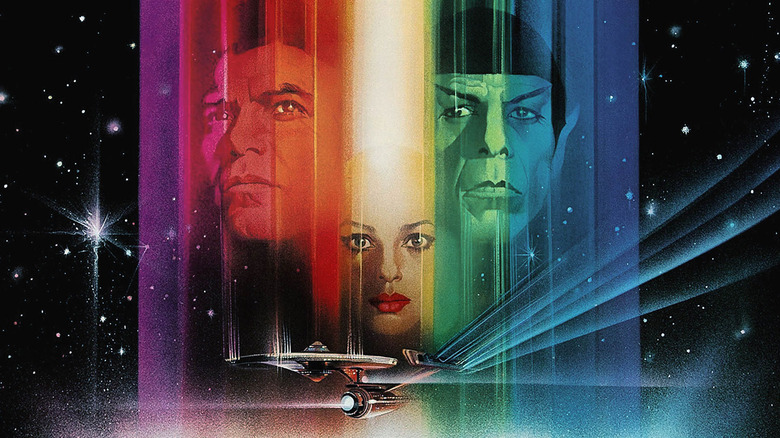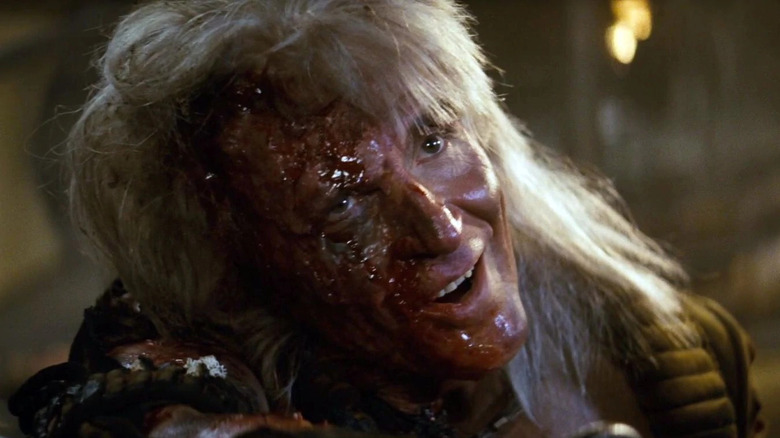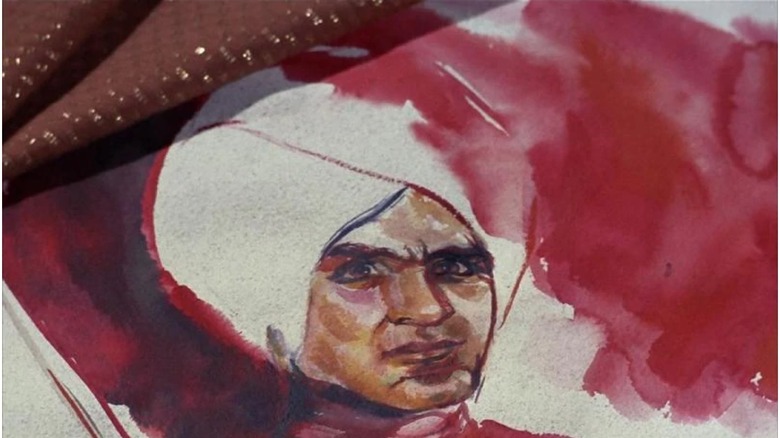Even A Die-Hard Trekkie Wouldn't Recognize The First Version Of A Classic Villain
Ask any "Star Trek" fan who the best villain in the series is, and you'll almost always get the same answer: Khan Noonien Singh. A genetically engineered superhuman, Khan and his augmented brethren ruled much of the world in the late 20th century ("Trek" couldn't be right every time it predicted the future!). Khan embodies mankind's history of bloody war and conquest, making him a perfect foil for the optimistic ideals of "Star Trek."
Sociology professors/bona fide Trekkies John and Maria Jose Tenuto researched the development of Khan from numerous primary sources and they were kind enough to share their findings in an interview with Gizmodo. The history of the making of the greatest villain in "Star Trek" history is as detailed and complex as you'd hope.
Planting the Space Seed
Per the Tenutos' scholarship, Khan's debut episode "Space Seed" was first pitched by Carey Wilbur. Wilbur was a prolific TV writer during the medium's early days, with credits on dozens of shows, but "Space Seed" was his only "Star Trek" credit. In Wilbur's draft, the character who would become Khan is a man of Nordic descent named Harold Erickson. As in the finished episode, Erickson and his ilk left Earth long ago aboard the SS Botany Bay and drifted through space for centuries. When the Enterprise discovers the ship, the crew awaken the villain to an unfamiliar world.
The similarities between Erickson and Khan end there. Erickson is a mere criminal who lacks the gravitas and thematic resonance of Khan; he's not a brutal dictator hiding behind charisma, just an opportunistic thug. Erickson and Khan share the same goal of seizing the Enterprise, but whereas Khan has the grand design of a new empire, Erickson just wants to be a space pirate.
Writer Gene L. Coon played a major role in revising Erickson into Khan. Coon felt the Enterprise crew needed worthy adversaries; his episode "An Errand Of Mercy" introduced the Klingons. He felt that with some tweaks, Erickson could be a Moriarty to Kirk's Sherlock Holmes; an equal and opposite to the Captain, rather than just another bad guy. In Coon's draft, John Erickson is the cover identity for Ragnar Thorwald, a warlord from Earth's past. Coon also introduces the villain's enhanced strength and intelligence, making him much more dangerous than how Wilbur first conceived of him.
Montalbán enters the picture
Casting director Joseph D'Agosta selected Ricardo Montalbán for the part, who was an incredible performer, but not the blond Viking who the writers had envisioned. In a wonderful decision, they changed the character instead of the casting. The multi-cultural casting of "Star Trek" was revolutionary; making a genius superman, the supposed apex of humanity, into a Sikh Indian was one of the series' most radical moves. A major misstep of Khan's most recent appearance, 2013's "Star Trek: Into Darkness," was casting the pale-as-snow Benedict Cumberbatch. "Space Seed" wasn't perfect (Montalbán is a Mexican man playing an Indian one), but it's still more forward-facing than that much younger film.
Montalbán's casting didn't just change Khan's ethnicity — it also rewrote his persona. Instead of a barbarian like Erickson, Khan was charming in spite of his ruthlessness. He even seduces Enterprise historian Lt. Marla McGivers (Madlyn Rhue) into helping him. As Tenuto put it, "once they knew that Montalbán was taking the role, you can see a shift in the dialogue to become more romantic." Roddenberry put on the finishing touch by selecting the villain's final name in tribute to his old WWII buddy, Kim Noonien Singh.
Setting the stage for Khan's return
At the end of "Space Seed," a defeated Khan chooses exile on planet Ceti Alpha V. Khan cites Milton's "Paradise Lost," "it is better to rule in Hell than to serve in Heaven." Khan never returned before "Star Trek" went off the air, for the 1960s were the days before TV serialization. However, you probably already know that "Space Seed" was not the end of his story. To understand how "Star Trek II: The Wrath Of Khan" came about, you must first understand its predecessor.
10 years after "Star Trek: The Original Series" ended, the original cast reunited for "Star Trek: The Motion Picture." That movie received unenthusiastic reviews and middling box office returns. As a result, the sequel came with a slashed budget ($44 million to $12 million). Roddenberry's original pitch did not feature Khan; instead, it was a spin on the classic episode "The City On The Edge Of Forever." In Roddenberry's "Star Trek II," the Enterprise crew would go back in time after disruptions to their present; they discover they need to ensure the assassination of JFK to protect history.
Paramount rejected Roddenberry's pitch and removed him from any role of true authority on the film. They then hired "Trek" novices Nicholas Meyer and Harv Bennett to direct and produce, respectively. According to "From Sawdust To Stardust," Terry Lee Rioux's biography of DeForest Kelley (aka Dr. Leonard "Bones" McCoy), Bennett suggested reusing Khan after watching "Space Seed." Despite the decreased budget, "The Wrath of Khan" became the shot in the arm that "Star Trek: The Motion Picture" failed to be and heralded four more sequels plus the franchise's return to television. The 1982 film is also why Trekkies remember Khan as more than just a good villain of the week.
An Ahab for the 23rd century
Aging and the passage of time are the major themes in "The Wrath of Khan." Instead of trying to hide how the cast had grown older, the film embraced it. "Khan" takes place on Captain Kirk's 50th birthday, and the once-proud hero is downtrodden, feeling that he's too worn out to be the adventurer he was in his youth. So, it's only fitting that an old foe from Kirk's glory days is the villain.
Shortly after Khan's people settled on Ceti Alpha V, an interplanetary disaster rendered the planet uninhabitable. While Kirk forgot about Khan, Khan never forgot about Kirk. When the film begins, he's waited 15 years to take his revenge and finally gets an opportunity when the starship Reliant visits the augments' desert prison. After seizing the Reliant, Khan becomes a cosmic Captain Ahab. He even paraphrases "Moby Dick" to explain his pursuit: "[Kirk] tasks me. He tasks me and I shall have him! I'll chase him 'round the moons of Nibia and 'round the Antares Maelstrom and 'round perdition's flames before I give him up!"
Khan dies quoting Melville too, "To the last, I grapple with thee; From Hell's heart, I stab at thee; For hate's sake, I spit my last breath at thee." Unlike Ahab though, who inflicted only some minor wounds on the great white whale, Khan pierces Kirk's very soul with his last act. Spock sacrifices himself to get the Enterprise to safety, and Kirk has to watch his best friend breathe his last breath. In that moment, Khan did worse than kill Kirk: he hurt him.
A dark mirror of human advancement
How ironic that in a series that chronicles adventures across the galaxy, the perfect villain is still a human being. In "Space Seed," Spock delivers a concise explanation for the augments' conquest of 20th century Earth: "superior ability breeds superior ambition." Yet despite his superior genetics, Khan embodies some of the most basic and violent aspects of humanity. Like all dictators, he built a regime on subjugation, and throughout "The Wrath Of Khan," he repeatedly sacrifices sense in his quest for vengeance.
Khan's contradictory nature, evolved yet primal, makes him the perfect foil for the ideals of the Federation and "Star Trek" itself. "Trek" charts an optimistic future based on diplomacy, exploration, and understanding. While 23rd-century humans have risen above their worst impulses, we in the present have a ways to go. If the human race is to evolve and overcome, we must leave behind men like Khan.
The behind-the-scenes story of Khan Noonien Singh is a tribute to the importance of collaboration in art. Wilbur provided the pitch, but Khan became Khan thanks to Coon and Roddenberry's revisions and Montalbán's mesmerizing performance. It's impossible to know if a two-bit criminal like Harold Erickson would've become as iconic a villain as Khan Noonien Singh. I wouldn't bet on it though.
